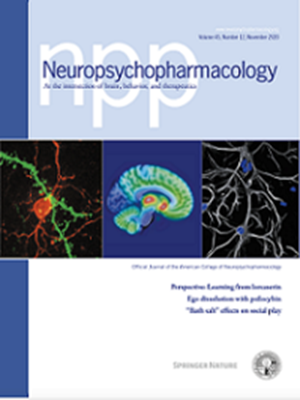Frontostriatal regulation of brain circuits contributes to flexible decision making
IF 6.6
1区 医学
Q1 NEUROSCIENCES
引用次数: 0
Abstract
Deficits in behavioral or cognitive flexibility that are linked to altered activity in both cortical and subcortical brain regions, are often observed across multiple neuropsychiatric disorders. The medial prefrontal cortex (mPFC)-nucleus accumbens (NAc) pathway in rats plays a critical role in flexible control of behavior. However, the modulation of this pathway on activity and functional connectivity with the rest of the brain remains unclear. In this study, we first confirmed the role of the mPFC-NAc pathway in behavioral flexibility using a set-shifting task in rats and then evaluated the causal effects of mPFC-NAc activation induced by chemogenetic stimulation of the terminal axons of the NAc with DREADD expression on whole-brain activity and functional connectivity measured by functional MRI. mPFC-NAc activation improved performance on the set-shifting task by reducing perseverative errors. Additionally, stimulation of this pathway increased activity in a set of brain regions within the basal ganglia-thalamus-cortical loop network including NAc, thalamus, hypothalamus and various connected cortical regions, while also decreased functional connectivity strength of NAc-mPFC, NAc-secondary motor cortex (M2), and various cortical circuits. Moreover, performance on the set-shifting task was related to the functional connectivity strength of the above frontostriatal and cortical circuits. These findings provide insights into the link between specific frontostriatal circuits on decision making flexibility, which may inform potential future interventions for behavioral flexibility deficits.

额纹状体调节脑回路有助于灵活的决策。
行为或认知灵活性的缺陷与大脑皮层和皮层下区域活动的改变有关,经常在多种神经精神疾病中观察到。大鼠内侧前额叶皮层(mPFC)-伏隔核(NAc)通路在行为灵活控制中起关键作用。然而,这一通路对活动和与大脑其他部分的功能连接的调节尚不清楚。在这项研究中,我们首先通过大鼠的集移任务证实了mPFC-NAc通路在行为灵活性中的作用,然后通过功能MRI评估了mPFC-NAc激活对全脑活动和功能连通性的因果影响。mPFC-NAc激活通过减少持续性错误提高了集转移任务的性能。此外,该通路的刺激增加了基底神经节-丘脑-皮层环路网络内的一组大脑区域的活动,包括NAc、丘脑、下丘脑和各种连接的皮层区域,同时也降低了NAc- mpfc、NAc-次级运动皮层(M2)和各种皮层回路的功能连接强度。此外,设置转移任务的表现与上述额纹状体和皮层回路的功能连接强度有关。这些发现为特定额纹状体回路与决策灵活性之间的联系提供了见解,这可能为行为灵活性缺陷的潜在未来干预提供信息。
本文章由计算机程序翻译,如有差异,请以英文原文为准。
求助全文
约1分钟内获得全文
求助全文
来源期刊

Neuropsychopharmacology
医学-精神病学
CiteScore
15.00
自引率
2.60%
发文量
240
审稿时长
2 months
期刊介绍:
Neuropsychopharmacology is a reputable international scientific journal that serves as the official publication of the American College of Neuropsychopharmacology (ACNP). The journal's primary focus is on research that enhances our knowledge of the brain and behavior, with a particular emphasis on the molecular, cellular, physiological, and psychological aspects of substances that affect the central nervous system (CNS). It also aims to identify new molecular targets for the development of future drugs.
The journal prioritizes original research reports, but it also welcomes mini-reviews and perspectives, which are often solicited by the editorial office. These types of articles provide valuable insights and syntheses of current research trends and future directions in the field of neuroscience and pharmacology.
 求助内容:
求助内容: 应助结果提醒方式:
应助结果提醒方式:


